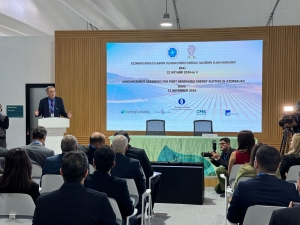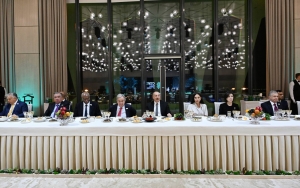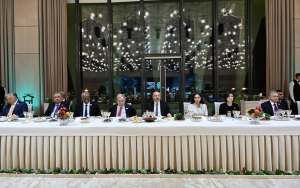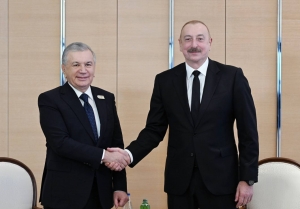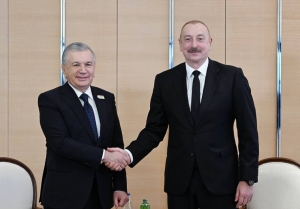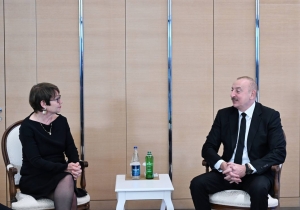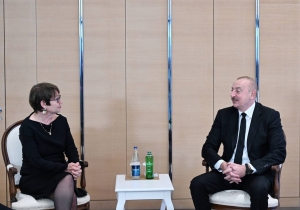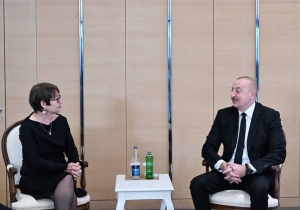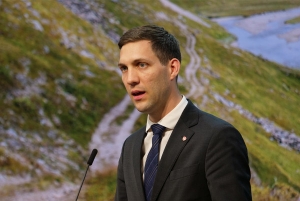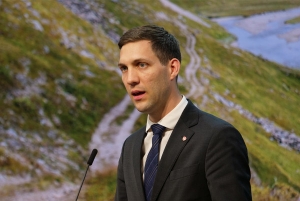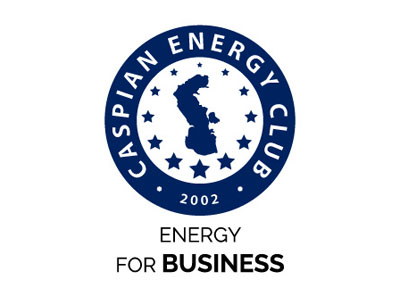Super User
COP29 çərçivəsində ilk bərpa olunan enerji hərracının qalibi elan edilib
COP29 çərçivəsində Avropa Yenidənqurma və İnkişaf Bankının (AYİB) dəstəyi ilə həyata keçirilən 100 MVt gücündə Qobustan Günəş Elektrik Stansiyasının tikintisi üzrə hərracın qalibi elan olunub.
Hər kilovat-saat elektrik enerjisi üçün ən aşağı təklif verən “Universal International Holdings Limited” şirkəti hərracda qalib gəlib. 2027-ci ildə istismara verilməsi nəzərdə tutulan stansiyada hər il təxminən 260 milyon kilovat-saat elektrik enerjisi istehsalı proqnozlaşdırılır. Bu isə ildə 57 milyon kubmetr həcmində təbii qaza qənaət etməklə yanaşı, atmosferə atılan karbon emissiyalarını 124 min ton azaltmağa imkan verəcək.
Bu barədə “Caspian Energy Media” Energetika Nazirliyinə istinadən xəbər verir.
Дан прием в честь глав государств и правительств, участвовавших в церемонии открытия Саммита лидеров COP29
12 ноября во дворце «Гюлистан» в Баку от имени Президента Азербайджанской Республики Ильхама Алиева был дан прием в честь глав государств и правительств, участвовавших в церемонии открытия Саммита лидеров 29-й сессии Конференции сторон Рамочной конвенции ООН об изменении климата (COP29).
В мероприятии приняли участие Президент Ильхам Алиев и первая леди Мехрибан Алиева.
Об этом сообщает “Caspian Energy Media” со ссылкой на официальный сайт главы Азербайджанского государства.
Reception held in honor of heads of state and government attending opening ceremony of World Leaders Climate Action Summit at COP29
On November 12, Ilham Aliyev, the President of the Republic of Azerbaijan, hosted a reception at the Gulustan Palace in Baku in honor of the heads of state and government attending the opening ceremony of the World Leaders Climate Action Summit at the 29th session of the Conference of the Parties (COP29) to the UN Framework Convention on Climate Change.
President Ilham Aliyev and First Lady Mehriban Aliyeva attended the event.
“Caspian Energy Media” reports with reference to the official website of the President of Azerbaijan.
Ilham Aliyev met with President of Uzbekistan Shavkat Mirziyoyev
On November 13, Ilham Aliyev, President of the Republic of Azerbaijan, met with Shavkat Mirziyoyev, President of the Republic of Uzbekistan.
Shavkat Mirziyoyev congratulated Azerbaijan on the successful hosting of COP29, commending the excellent organization of the event.
“Caspian Energy Media” reports with reference to the official website of the President of Azerbaijan.
Ильхам Алиев встретился с Президентом Узбекистана Шавкатом Мирзиёевым
13 ноября Президент Азербайджанской Республики Ильхам Алиев встретился с Президентом Республики Узбекистан Шавкатом Мирзиёевым.
Шавкат Мирзиёев поздравил с успешным проведением COP29, подчеркнул, что это мероприятие организовано на очень высоком уровне.
Об этом сообщает “Caspian Energy Media” со ссылкой на официальный сайт главы Азербайджанского государства.
Ilham Aliyev met with President of European Bank for Reconstruction and Development
On November 13, President of the Republic of Azerbaijan Ilham Aliyev Ilham Aliyev met with Odile Renaud-Basso, President of the European Bank for Reconstruction and Development (EBRD).
First, the signing ceremony of the “Memorandum of Understanding between the Ministry of Economy of the Republic of Azerbaijan, the Azerbaijan State Water Resources Agency and the European Bank for Reconstruction and Development on reconstruction of water supply, sanitation and stormwater management network and construction of wastewater treatment plant in Ganja" was held with the participation of President Ilham Aliyev and EBRD President Odile Renaud-Basso.
“Caspian Energy Media” reports with reference to the official website of the President of Azerbaijan.
Ильхам Алиев встретился с президентом Европейского банка реконструкции и развития
13 ноября Президент Азербайджанской Республики Ильхам Алиев встретился с президентом Европейского банка реконструкции и развития (ЕБРР) Одиль Рено-Бассо.
Сначала с участием Президента Ильхама Алиева и президента Европейского банка реконструкции и развития (ЕБРР) Одиль Рено-Бассо состоялась церемония подписания «Меморандума о взаимопонимании по реконструкции систем водоснабжения и канализации, системы управления дождевыми водами и строительству установки по очистке сточных вод в городе Гянджа между Министерством экономики Азербайджанской Республики, Государственным агентством водных ресурсов Азербайджана и Европейским банком реконструкции и развития».
Об этом сообщает “Caspian Energy Media” со ссылкой на официальный сайт главы Азербайджанского государства.
İlham Əliyev Avropa Yenidənqurma və İnkişaf Bankının prezidenti ilə görüşüb
Noyabrın 13-də Azərbaycan Respublikasının Prezidenti İlham Əliyev Avropa Yenidənqurma və İnkişaf Bankının (EBRD) prezidenti Odil Reno-Basso ilə görüşüb.
Əvvəlcə Prezident İlham Əliyev və Avropa Yenidənqurma və İnkişaf Bankının prezidenti Odil Reno-Bassonun iştirakı ilə “Gəncə şəhərində su təchizatı və kanalizasiya sistemlərinin, yağış sularının idarəetmə sisteminin yenidən qurulması və tullantı sularının təmizlənməsi qurğusunun tikintisi üzrə Azərbaycan Respublikasının İqtisadiyyat Nazirliyi, Azərbaycan Dövlət Su Ehtiyatları Agentliyi və Avropa Yenidənqurma və İnkişaf Bankı arasında Anlaşma Memorandumu”nun imzalanması mərasimi oldu.
Bu barədə “Caspian Energy Media” Prezidentin Mətbuat xidmətinə istinadən xəbər verir.
Норвежская экономика достаточно устойчива, Андреас Бьелланд Эриксен, Министр климата и окружающей среды Норвегии
Caspian Energy (EU): Г-н министр, какие надежды Вы возлагаете на рамочную конференцию ООН COP29, какой Вы видите роль нефтедобывающих стран на данном мероприятии?
Министр климата и окружающей среды Норвегии Андреас Бьелланд Эриксен: Я надеюсь на амбициозный результат, который приблизит нас на шаг к достижению цели в 1,5 градуса. В частности, нам нужен результат, который наращивает международное финансирование для энергетического перехода. Необходимо повысить амбициозность действий по предотвращению изменения климата на всех уровнях и во всех процессах. Это включает, но не ограничивается рабочей программой по амбициозности и осуществлению действий по предотвращению изменения климата. Я ожидаю, что все стороны будут конструктивно работать для достижения цели сдерживания глобального потепления на уровне 1,5 градуса.
CE: Нужно ли запретить добычу углеводородов на Северном море, согласно решению норвежского суда?
Андреас Бьелланд Эриксен: Правительство считает, что процесс лицензирования и утверждения разработки и эксплуатации трех новых нефтяных и газовых месторождений в Северном море соответствует всем применимым критериям и был осуществлен правильно. Решение окружного суда Осло, включая судебный запрет, требующий приостановить все разработки и добычу на этих трех месторождениях до тех пор, пока дело не будет урегулировано, было обжаловано правительством и не является юридически обязательным решением. В ожидании окончательного решения по делу Апелляционный суд отменил приведение судебного запрета в исполнение. Таким образом, непосредственного влияния на текущую деятельность, осуществляемую на норвежском континентальном шельфе, это не оказывает. Пока еще слишком рано говорить о том, какие последствия будет иметь вынесение юридически обязательного решения.
CE: Сегодня Азербайджан призывает страны COP29 решить вопрос финансирования триллионной климатической повестки дня, каким Вы видите решение данного вопроса?
Андреас Бьелланд Эриксен: Значительная часть необходимых инвестиций рентабельна в долгосрочной перспективе и при благоприятных условиях. Однако отчасти из-за реальных и предполагаемых рисков стоимость капитала по-прежнему является барьером для необходимых инвестиций в большинстве развивающихся стран. Поэтому мы должны наращивать международное финансирование переходного периода. Что необходимо, так это капитал, инвестиции, а также стабильная нормативно-правовая база, стимулирующая переход.
CE: Сегодня температура потепления климата достигла 1,6 С по сравнению с доиндустриальным периодом, как это отразилось на экономике Норвегии?
Андреас Бьелланд Эриксен: Изменение климата затрагивает все сферы жизни общества и влечет за собой значительные издержки для общества. Комиссия по климатическим рискам, которая в 2018 году оценила факторы риска, связанные с климатом, и их значение для норвежской экономики, отметила, что норвежская экономика выглядит относительно устойчивой. Однако изменения, воздействующие на Норвегию, так и побочные эффекты изменения климата в других странах порождают экономические последствия, поскольку Норвегия является небольшой, открытой экономикой. Последствия изменения климата в значительной степени не поддаются количественной оценке, и трудно оценить точные затраты. Поэтому правительство учредило комитет экспертов для получения дополнительной информации о социально-экономических последствиях изменения климата для уязвимых секторов и регионов. Экспертная группа представит свой отчет к июлю 2026 года.
Благодарим вас за интервью.
Norwegian economy appears to be relatively robust, Andreas Bjelland Eriksen, Minister of Climate and Environment of Norway
Caspian Energy (EU): Mr. Eriksen, what hopes do you rest on the UN Climate Change Conference (COP29) and what role do you assign to the oil-producing countries in the upcoming event?
Andreas Bjelland Eriksen, Minister of Climate and Environment of Norway: I hope for an ambitious outcome that will take us a step closer to achieving the 1.5. degree target. Specifically, we need an outcome that ramps up international financing for the energy transition. We also need to strengthen mitigation ambition and implementation at all levels, and in all processes. This includes, but is not limited to, the mitigation ambition and implementation work programme. I expect all parties to work constructively towards the 1.5 target.
CE: Should the hydrocarbon production in the North Sea be halted, as decided by the Norwegian court?
Andreas Bjelland Eriksen: The Government’s view is that the process with licensing and approval of development and operation on the three new oil and gas fields in the North Sea meets all applicable criteria and was carried out correctly. The decision from Oslo District Court, including the injunction requiring a halt to all development and production on these three fields until the case is settled, has been appealed by the Government and is not a legally binding judgment. Pending a final decision in the case, the Court of Appeal set aside the enforceability of the injunction. Therefore, it does not have any immediate impact on ongoing activity carried out on the Norwegian continental shelf. It is too early to say anything about what consequences the outcome of a legally binding judgment will have.
CE: Today, Azerbaijan is calling on COP29 states to address the financing of the trillion-dollar climate agenda. What solution do you suggest to this matter?
Andreas Bjelland Eriksen: A large part of the necessary investments are profitable in the long term and in the right conditions. However, partly due to real and perceived risks, the cost of capital is still a barrier for necessary investments for most developing countries. Therefore, we must ramp up international financing for the transition. What is needed is capital, investments, but also a stable regulatory framework that incentivizes the transition.
CE: The global temperatures averaged 1.6 degrees Celsius above pre-industrial levels. Did it cause challenges for the economy of Norway?
Andreas Bjelland Eriksen: Climate change affects all areas of society and entails considerable costs for society. The Climate Risk Commission, which assessed climate-related risk factors and their significance for the Norwegian economy in 2018, pointed out that that the Norwegian economy appears to be relatively robust. However, both the changes that affect Norway and the spillover effects of climate change in other countries have economic consequences, as Norway is a small, open economy. The consequences of climate change are not quantified to any great extent, and it is difficult to estimate exact costs. The Government has therefore appointed an expert committee to obtain more knowledge about the socio-economic consequences of climate change for vulnerable sectors and regions. The expert group will submit its report by July 2026.
Thank you for the interview.




